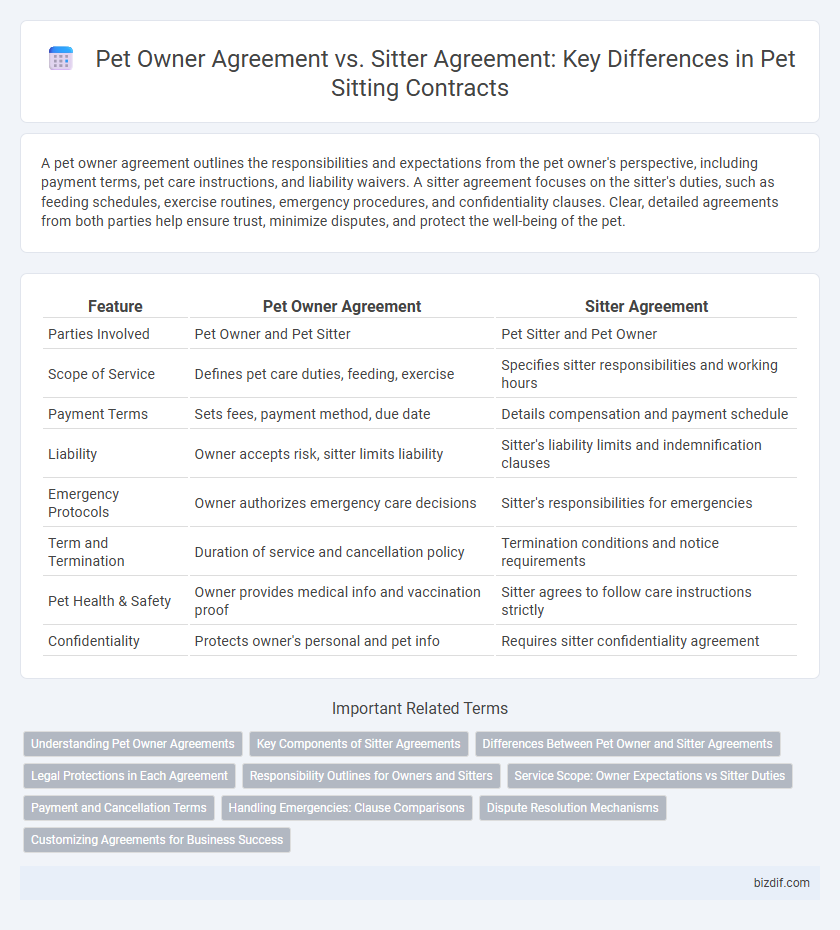A pet owner agreement outlines the responsibilities and expectations from the pet owner's perspective, including payment terms, pet care instructions, and liability waivers. A sitter agreement focuses on the sitter's duties, such as feeding schedules, exercise routines, emergency procedures, and confidentiality clauses. Clear, detailed agreements from both parties help ensure trust, minimize disputes, and protect the well-being of the pet.
Table of Comparison
| Feature | Pet Owner Agreement | Sitter Agreement |
|---|---|---|
| Parties Involved | Pet Owner and Pet Sitter | Pet Sitter and Pet Owner |
| Scope of Service | Defines pet care duties, feeding, exercise | Specifies sitter responsibilities and working hours |
| Payment Terms | Sets fees, payment method, due date | Details compensation and payment schedule |
| Liability | Owner accepts risk, sitter limits liability | Sitter's liability limits and indemnification clauses |
| Emergency Protocols | Owner authorizes emergency care decisions | Sitter's responsibilities for emergencies |
| Term and Termination | Duration of service and cancellation policy | Termination conditions and notice requirements |
| Pet Health & Safety | Owner provides medical info and vaccination proof | Sitter agrees to follow care instructions strictly |
| Confidentiality | Protects owner's personal and pet info | Requires sitter confidentiality agreement |
Understanding Pet Owner Agreements
Pet owner agreements clearly outline responsibilities, care instructions, and liability terms to protect both the pet owner and the sitter during pet sitting services. Understanding these agreements ensures pet owners communicate specific needs, health requirements, and emergency protocols effectively. Detailed pet owner agreements reduce misunderstandings and provide legal protection, establishing a foundation of trust between both parties.
Key Components of Sitter Agreements
Sitter agreements outline specific responsibilities, including pet care instructions, emergency protocols, payment terms, and liability waivers, ensuring clarity between the pet sitter and owner. They often include confidentiality clauses and stipulations about pet health and behavior to protect both parties. Detailed sitter agreements reduce misunderstandings and provide a legal framework for resolving disputes effectively.
Differences Between Pet Owner and Sitter Agreements
Pet owner agreements primarily outline the responsibilities, expectations, and liabilities of the pet owner, including details about pet care, emergency contacts, and payment terms. Sitter agreements focus on the duties and conduct required of the pet sitter, specifying service scope, confidentiality, and indemnity clauses. The key difference lies in the perspective and obligations each party assumes, with pet owner agreements protecting owners' interests, while sitter agreements safeguard service providers.
Legal Protections in Each Agreement
Pet owner agreements outline the responsibilities and expectations between the pet owner and sitter, establishing liability limits and care standards to protect both parties legally. Sitter agreements focus on the sitter's duties, hours, and compensation terms, providing legal safeguards against disputes related to service delivery and payment. Clear legal protections in each agreement minimize risks of misunderstandings and ensure compliance with regional pet care regulations.
Responsibility Outlines for Owners and Sitters
Pet owner agreements explicitly outline the responsibilities of owners, including providing accurate pet information, emergency contacts, and detailed care instructions to ensure the sitter can meet the animal's needs. Sitter agreements focus on the sitter's obligations such as offering attentive care, maintaining pet safety, adhering to feeding schedules, and reporting any health or behavior changes promptly. Clear responsibility outlines in both agreements help prevent misunderstandings and promote a seamless pet sitting experience.
Service Scope: Owner Expectations vs Sitter Duties
A Pet Owner Agreement clearly outlines the owner's expectations regarding pet care, including feeding schedules, exercise routines, medication administration, and emergency protocols. In contrast, a Pet Sitter Agreement specifies the sitter's duties and responsibilities, such as adhering to owner instructions, ensuring pet safety, and providing updates during the sitting period. Defining the service scope in both agreements establishes accountability, minimizes misunderstandings, and ensures comprehensive pet care.
Payment and Cancellation Terms
Pet owner agreements typically outline payment terms requiring upfront deposits or full payment before services begin, while sitter agreements often specify invoicing schedules and payment methods accepted. Cancellation policies in pet owner agreements usually include deadlines for refunds or rescheduling fees, whereas sitter agreements emphasize notice periods and penalties for late cancellations. Clear terms in both agreements protect financial interests and ensure mutual understanding of payment obligations and cancellation consequences.
Handling Emergencies: Clause Comparisons
Pet owner agreements typically emphasize the owner's consent for emergency medical treatment and specify preferred veterinary contacts, ensuring clear authorization before any intervention. Sitter agreements focus on the sitter's responsibilities and the protocols they must follow during emergencies, including immediate notification procedures and limits on medical decisions. Both agreements prioritize clear communication but differ in assigning authority and outlining specific emergency actions to protect pet welfare and manage liability.
Dispute Resolution Mechanisms
Pet owner agreements typically include dispute resolution mechanisms that prioritize mediation or arbitration to address conflicts efficiently and maintain client trust. Sitter agreements often specify step-by-step procedures, including negotiation clauses and jurisdiction settings, to protect both parties' legal rights in case of disputes. Clear and mutually agreed-upon resolution methods reduce the risk of litigation and ensure smoother conflict management between pet owners and sitters.
Customizing Agreements for Business Success
Customizing pet owner agreements versus sitter agreements allows pet sitting businesses to clearly define specific responsibilities and liabilities tailored to each party, minimizing legal risks. Pet owner agreements typically emphasize care expectations, emergency protocols, and fee structures, while sitter agreements focus on work scope, confidentiality, and code of conduct. Tailored agreements enhance trust, streamline operations, and protect both the sitter and pet owner, driving overall business success.
Pet owner agreement vs Sitter agreement Infographic

 bizdif.com
bizdif.com